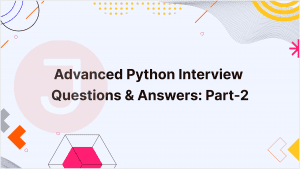Are you preparing for a Python interview and seeking to ensure your readiness for questions at every level? Python, one of the most popular programming languages, continually attracts employers in search of proficient Python developers. To assist you in excelling in your Python interview, we’ve assembled the top 30 Python interview questions and answers, commencing with the fundamentals and advancing to more intermediate topics. Let’s begin!
Table of Contents
- 1 Questions from Beginner to Intermediate Levels [Part 1]
- 1.1 1. What is Python?
- 1.2 2. What is PEP 8?
- 1.3 3. What are Python namespaces and scopes?
- 1.4 4. Explain the difference between list and tuple in Python.
- 1.5 5. What is a Python decorator?
- 1.6 6. Describe the purpose of the __init__ method in Python classes.
- 1.7 7. How does Python’s garbage collection work?
- 1.8 8. What is a lambda function, and how is it different from a regular function?
- 1.9 9. Explain list comprehension in Python.
- 1.10 10. What is the Global Interpreter Lock (GIL)?
- 1.11 11. What are the key differences between Python 2 and Python 3?
- 1.12 12. How can you handle exceptions in Python?
- 1.13 13. What is the purpose of the yield keyword in Python?
- 1.14 14. What are decorators in Python, and why are they useful?
- 1.15 15. What is the Global Interpreter Lock (GIL), and how does it impact Python’s multithreading?
- 1.16 16. Describe the purpose of the __str__ and __repr__ methods in Python classes.
- 1.17 17. What is the difference between a shallow copy and a deep copy in Python?
- 1.18 18. Explain the concept of Python’s garbage collection.
- 1.19 19. How do you open and close a file in Python?
- 1.20 20. What is the purpose of the with statement in Python file handling?
- 1.21 21. How do you sort a list in Python?
- 1.22 22. Explain the difference between deep and shallow copy in Python.
- 1.23 23. What are Python virtual environments, and why are they important?
- 1.24 24. Describe the purpose of Python’s __init__ method.
- 1.25 25. How do you handle exceptions in Python?
- 1.26 26. What is the purpose of Python’s zip() function?
- 1.27 27. What are the key features of Python 3 compared to Python 2?
- 1.28 28. Explain the use of join() in Python strings.
- 1.29 29. How does Python manage memory and prevent memory leaks?
- 1.30 30. What is a decorator in Python, and how is it useful?
- 2 Conclusion
- 3 FAQ
Questions from Beginner to Intermediate Levels [Part 1]
1. What is Python?
Answer: Python is a high-level, interpreted programming language known for its simplicity and readability.
2. What is PEP 8?
Answer: PEP 8 is a style guide for writing clean and consistent Python code.
3. What are Python namespaces and scopes?
Answer: Namespaces are containers for variables, and scopes define the visibility and accessibility of variables.
4. Explain the difference between list and tuple in Python.
Answer: Lists are mutable, while tuples are immutable.
5. What is a Python decorator?
Answer: A decorator is a function that modifies the behavior of another function.
6. Describe the purpose of the __init__ method in Python classes.
Answer: The __init__ method is used to initialize object attributes when an instance of a class is created.
7. How does Python’s garbage collection work?
Answer: Python uses reference counting and cyclic garbage collection to manage memory.
8. What is a lambda function, and how is it different from a regular function?
Answer: A lambda function is an anonymous, one-liner function that can be used for simple operations.
9. Explain list comprehension in Python.
Answer: List comprehension is a concise way to create lists based on existing lists or iterables.
10. What is the Global Interpreter Lock (GIL)?
Answer: The GIL is a mutex in CPython that allows only one thread to execute in a Python process at a time.
11. What are the key differences between Python 2 and Python 3?
Answer: Python 3 is the latest version and has several improvements over Python 2, including better Unicode support and syntax changes.
12. How can you handle exceptions in Python?
Answer: Exceptions are handled using the try, except, and finally blocks.
13. What is the purpose of the yield keyword in Python?
Answer: yield is used in generator functions to produce a series of values lazily.
14. What are decorators in Python, and why are they useful?
Answer: Decorators are functions that modify the behavior of other functions or methods, often used for tasks like logging, authentication, and more.
15. What is the Global Interpreter Lock (GIL), and how does it impact Python’s multithreading?
Answer: The GIL is a mutex that ensures only one thread executes in a Python process at a time, making it challenging to achieve true parallelism with multithreading.
16. Describe the purpose of the __str__ and __repr__ methods in Python classes.
Answer: __str__ is used for user-friendly string representations, while __repr__ provides unambiguous representations.
17. What is the difference between a shallow copy and a deep copy in Python?
Answer: A shallow copy creates a new object but does not duplicate nested objects, while a deep copy duplicates all objects, including the nested ones.
18. Explain the concept of Python’s garbage collection.
Answer: Python uses reference counting and cyclic garbage collection to manage memory automatically.
19. How do you open and close a file in Python?
Answer: You can use the open() function to open a file and the close() method to close it.
20. What is the purpose of the with statement in Python file handling?
Answer: The with statement ensures proper file cleanup and resource management by automatically closing the file when the block is exited.
21. How do you sort a list in Python?
Answer: You can use the sorted() function to sort a list, or the sort() method to sort it in place.
22. Explain the difference between deep and shallow copy in Python.
Answer: A deep copy creates a completely independent duplicate, while a shallow copy creates a new object, but references nested objects.
23. What are Python virtual environments, and why are they important?
Answer: Virtual environments are isolated environments for Python projects, allowing you to manage dependencies and avoid conflicts.
24. Describe the purpose of Python’s __init__ method.
Answer: The __init__ method is used to initialize object attributes when an instance of a class is created.
25. How do you handle exceptions in Python?
Answer: Exceptions are handled using try, except, and optionally, finally blocks.
26. What is the purpose of Python’s zip() function?
Answer: The zip() function combines multiple iterables into a single iterable, creating pairs of corresponding elements.
27. What are the key features of Python 3 compared to Python 2?
Answer: Python 3 offers improved Unicode support, enhanced syntax, and numerous other enhancements over Python 2.
28. Explain the use of join() in Python strings.
Answer: The join() method is used to concatenate elements of an iterable into a single string using a specified separator.
29. How does Python manage memory and prevent memory leaks?
Answer: Python uses reference counting and a cyclic garbage collector to reclaim memory automatically.
30. What is a decorator in Python, and how is it useful?
Answer: A decorator is a function that modifies the behavior of another function, often used for tasks like authentication and logging.
Conclusion
In this blog, we’ve covered the first 30 Python interview questions and answers, spanning from fundamental to intermediate levels. To prepare effectively for your Python interview, make sure to thoroughly understand and practice these questions. Stay tuned for the next part of this blog series, where we will delve into more intermediate and advanced Python interview questions and offer detailed answers to boost your readiness for the Python interview.
To read the second part of our Python interview questions series, visit Part 2.
FAQ
Python interview questions assess a candidate’s knowledge and skills, helping employers gauge their suitability for Python-related roles.
Python 3 is the latest version of the language and includes improvements and syntax changes. Python 2 is no longer supported, and developers are encouraged to use Python 3 for new projects
Python uses an automatic memory management system with a garbage collector, handling memory allocation and deallocation for efficient resource utilization.
A decorator is a special type of function that can be used to modify the behavior of another function. It is denoted by the @decorator syntax.
Exceptions in Python are handled using the try, except, else, and finally blocks, providing a structured way to manage errors.




